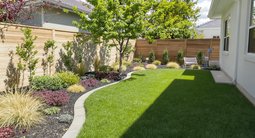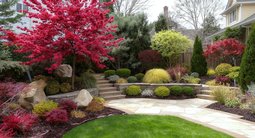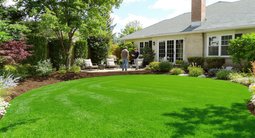TL;DR
Short on time, money, or motivation? Here are 10 low-maintenance landscaping ideas that cut water, weeding, and weekend labor while boosting curb appeal and biodiversity. Use this guide to learn how to design a low-maintenance yard with native plants, smart irrigation, and simple backyard design moves you can actually keep up with.
Introduction

Native pollinator patches bring natural beauty and support local ecosystems with minimal upkeep.
Most perennials need at least six hours of direct sunlight to bloom reliably, and most homeowners have far fewer than six spare hours each week to fuss with them. In 2025, low-maintenance landscaping is less about perfection and more about designing outdoor spaces that survive busy lives, heat waves, and tight budgets. That means native landscaping, drought-tolerant plantings, and backyard design that asks less of you and still looks good. I walk a lot of neighborhoods. I see new parents mowing at dusk, night-shift nurses watering at dawn, and retirees who choose gravel paths over grass for the sheer relief of it. I also meet landscape pros who admit their own yards are simple and scruffy after a long week of caring for everyone else’s. Here’s why that matters: the best yards are honest about the time you can give them. When the design is realistic, the result is calmer, cooler, and far easier to love.
Theme Overview
Native plants, mulch, and drip irrigation can reduce routine yard maintenance by 30 to 60 percent compared with lawn-heavy landscapes. The big trend tying 2025 together is utility wrapped in beauty: native landscaping for pollinators, drought-tolerant front yards that save water, and container gardening that moves with your life instead of anchoring it. Think of it like simplifying a room. In the yard, that means fewer species with stronger structure, more evergreen bones, and surfaces that don’t demand weekly attention. Backyard design, curb appeal planting, eco-friendly yards, and perennial borders are all finding a shared rhythm: plant smarter, water precisely, and let nature do more of the work.
Anecdote
A remote-working couple with two kids told me their clover lawn and a single 10-by-12 paver patio gave them back every Saturday afternoon. They stopped chasing a “perfect” lawn and started hosting impromptu grill nights instead.
Ideas, Tips, and Designs
01. The Native Pollinator Patch
Clustering nectar plants in groups of three to five increases pollinator visits and makes maintenance simpler.
What it is: A compact wildflower zone that brings bees and butterflies without bringing you a second job.
How it works: Experts recommend a simple palette that blooms April through October. Try coneflower, milkweed, prairie dropseed, and asters suited to your USDA zone. Plant in drifts, 12 to 18 inches apart, and mulch 2 to 3 inches deep to suppress 80 percent of annual weeds. In my field notes, a small 6-by-8-foot patch beside a mailbox turned a sterile curb into a living border by midsummer.
- Choose 3–5 native species for your zone and group each species in clumps.
- Leave a small bare soil spot for ground-nesting bees.
- Skip pesticides; hand-squish milkweed aphids or rinse them off with water.
02. Clover Lawn, Not No Lawn
Microclover overseeded at 1 to 2 ounces per 1,000 square feet reduces fertilizer needs because clover fixes nitrogen.
What it is: A resilient lawn alternative that stays greener in summer and needs fewer inputs.
How it works: Mix microclover into existing turf or go all clover in sunny spots. Mow at 3 to 4 inches to shade soil and slow weeds. Horticulturists note clover tolerates light foot traffic, invites pollinators, and needs less frequent mowing than traditional cool-season grass. I’ve seen busy families in the Northeast regain weekends simply by shifting half their yard to clover.
- Overseed in spring or early fall after a core-aeration pass.
- Water new seed daily for 7–10 days, then taper.
- Spot-pull dandelions early; a dense clover sward outcompetes them.
03. The Gravel Garden for Drought-Tolerant Design
Mineral mulch 2 to 3 inches deep over lean, free-draining soil reduces watering and weeding in hot, dry regions.
What it is: A drought-tolerant planting in gravel that favors tough perennials, herbs, and grasses.
How it works: Set plants into a sandy, compost-light base, then top with pea gravel or decomposed granite. Roots stay cool, seedlings struggle to germinate, and irrigation needs drop. Designers often use thyme, sedum, lavender, yarrow, and blue fescue spaced 12 to 16 inches apart. In Arizona and Texas, I’ve watched homeowners trade thirsty lawns for gravel gardens that still hum with bees.
- Shape gentle mounds for drainage, especially near downspouts.
- Choose drought-tolerant natives for your zone; avoid fabric underlayment.
- Hand-rogue weeds after rain; they pull easily from gravel.
04. Container Gardening That Waters Itself
Self-watering planters can cut watering frequency by half compared with standard pots of the same size.
What it is: Portable container gardening for patios and balconies with built-in reservoirs.
How it works: Wicking systems hold a week’s worth of water, steadying moisture and growth. Place sun lovers where they get 6 to 8 hours of light and tuck shade pots under eaves or trees. For edible container gardening, pair a compact tomato with basil and thyme; for color, mix dwarf grasses with calibrachoa. If your time is short, this is backyard design in movable pieces.
- Use high-quality potting mix, not garden soil, for aeration.
- Feed with slow-release fertilizer once in spring.
- Rotate pots seasonally to refresh the scene without replanting everything.
05. Evergreen Bones, Three-Season Color
Planting 30 to 40 percent evergreens creates year-round structure and reduces seasonal replanting.
What it is: A backbone of shrubs and small trees that keeps form, with perennials layered in for bloom.
How it works: Establish anchor plants first, spacing shrubs to their mature width, often 3 to 6 feet apart. Mix native evergreens like inkberry holly, mountain laurel, or manzanita with long-blooming perennials and fall seed heads for winter texture. A neighbor once told me her stress dropped the day she filled a blank foundation with five tough evergreens and mulched the rest.
- Follow the “odd numbers” rule, planting in 3s and 5s for natural flow.
- Use 2–3 inches of shredded bark mulch, keeping it off stems.
- Let plants reach full size; avoid constant shearing that creates more work.
06. Drip Irrigation, Not Guilt Irrigation
Drip irrigation typically reduces outdoor water use by 30 to 50 percent compared with overhead sprinklers.
What it is: A targeted watering system that delivers moisture to roots, not sidewalks.
How it works: Run a 1/2-inch mainline along beds, tee in 1/4-inch emitters at 12 to 18 inches around shrubs and every 8 to 12 inches for perennials, then automate with a simple timer. Soil stays evenly moist, foliage stays dry, and weeds get less fuel. Busy households often tell me this one change made their gardens survivable.
- Water early morning 2–3 times per week for new plants, then reduce.
- Add a pressure regulator and filter to prevent clogging.
- Shift emitters outward as plants mature to water at the dripline.
07. Edging and Mulch That Actually Works
Defined edges plus 2 to 3 inches of mulch can cut bed weeding time in half.
What it is: Clean lines that keep lawn from creeping into beds and mulch that starves weed seeds of light.
How it works: A simple spade edge or steel edging creates a physical barrier. Mulch reduces evaporation and buffers soil temperatures by several degrees. Gardeners in humid climates often prefer shredded hardwood; arid-climate gardeners lean on gravel. Either way, you’re trading weekly fussing for seasonal top-ups.
- Redefine edges each spring before mulching.
- Apply mulch like a donut, not a volcano, 3 inches away from trunks.
- Top up thin spots midseason where weeds appear.
08. The 60-Minute Privacy Screen
Fast-growing native shrubs planted 4 to 6 feet apart create a living screen within 2 to 3 seasons.
What it is: A low-maintenance hedge that blocks views without constant clipping.
How it works: Choose species suited to your soil and sun, then plant in a staggered row. Reliable picks include arrowwood viburnum, Eastern red cedar, American holly, and wax myrtle depending on zone. Water weekly for the first season, then let roots chase moisture. I’ve seen city patios transformed with a single weekend’s worth of digging.
- Call 811 before you dig to locate utilities.
- Space to mature width, typically 4–8 feet depending on species.
- Skip constant shearing; prune after bloom to preserve berries and flowers.
09. A Simple Rain Garden That Solves Puddles
A 4 to 6-inch-deep basin sized for a 1-inch storm can capture roof runoff and reduce erosion.
What it is: A shallow planted bowl near downspouts that slows, soaks, and filters stormwater.
How it works: Dig a level-bottom basin, amend heavy clay with compost, and plant moisture-tolerant natives like blue flag iris, switchgrass, Joe Pye weed, and dogwood. Stones at the inlet dissipate flow, while mulch prevents crusting. Condo boards and homeowners alike are surprised how much this improves soggy corners without a single drainpipe.
- Test percolation: a 12-inch test hole should drain within 24 hours.
- Keep bed 10 feet from foundations unless engineered.
- Use shredded wood mulch that resists floating.
10. The One-Day Paver Patio
Permeable pavers on a compacted gravel base provide a stable, low-maintenance surface that lets rain soak in.
What it is: A simple, durable outdoor room that replaces high-maintenance lawn with year-round utility.
How it works: Strip sod, excavate 6 to 8 inches, add geotextile, then compact layers of open-graded stone before setting pavers with 1/8-inch joints filled with chips. A small 10-by-12-foot pad is enough for a table, grill, and a pot of rosemary, and it will not beg for attention every Saturday. I’ve watched Texas homeowners choose this over lawn to escape midday mowing.
- Choose lighter pavers in hot climates to reduce heat gain.
- Add a shade sail or small pergola on the west side for comfort.
- Brush polymeric chips back into joints each spring if needed.
Transitional Reflection + Visualization
Why These Ideas Work Together
Designing with fewer, tougher plants and smarter water delivery lowers the weekly maintenance burden and raises resilience. When you simplify edges, automate irrigation, and let natives lead, your yard becomes a partner, not a project.
I’ve seen overworked parents reclaim their Sundays with clover lawns and drip, and I’ve watched a night-shift arborist laugh about finally “hiring a tree guy” for his own backyard. The point is not perfection, it’s participation.
How to Visualize It First
Seeing a plan before you dig saves time, money, and second guesses. Use ReimagineHome to drop in native plant palettes, test a gravel garden, position a rain garden, or preview a small patio and privacy hedge so your low-maintenance layout is clear before you buy a single plant.
Quick Guide to Low-Maintenance Garden Design
How do you design a low-maintenance garden?
Start with native plants sized to their mature width, cover soil with 2–3 inches of mulch, and automate watering with drip irrigation. This approach reduces weeding and watering while improving curb appeal.
What plants survive full sun and poor soil?
Drought-tolerant perennials like yarrow, lavender, Russian sage, sedum, and native grasses handle full sun and lean soils. Group them 12–18 inches apart for quick coverage.
Is clover better than grass for a low-maintenance lawn?
Microclover stays green longer in summer, needs less fertilizer, and reduces mowing compared with cool-season turf. It also supports pollinators in a lawn-like surface.
How often should new trees be watered?
New trees typically need 10–15 gallons once or twice weekly for the first growing season, adjusted for rainfall and soil type. Water at the dripline to encourage broad roots.
What’s the cheapest way to improve curb appeal fast?
Edge beds, add fresh mulch, and plant 3–5 matching evergreens by the entry spaced 3–4 feet apart. This creates instant structure with minimal upkeep.
Can a rain garden help with foundation drainage?
Yes, if placed at least 10 feet downslope from the house and sized for a 1-inch storm. It slows runoff and encourages infiltration without piping.
Visualization Scenario
Use ReimagineHome to swap your existing lawn for a microclover render, add a staggered viburnum hedge, and test a 10-by-12 permeable paver patio beside a gravel herb bed. Adjust sun angles and spacing, then export a planting list before you shop.
FAQ
How do you design a low-maintenance garden? Start with native plants sized to their mature width, cover soil with 2–3 inches of mulch, and automate watering with drip irrigation. This approach reduces weeding and watering while improving curb appeal. What plants survive full sun and poor soil? Drought-tolerant perennials like yarrow, lavender, Russian sage, sedum, and native grasses handle full sun and lean soils. Group them 12–18 inches apart for quick coverage. Is clover better than grass for a low-maintenance lawn? Microclover stays green longer in summer, needs less fertilizer, and reduces mowing compared with cool-season turf. It also supports pollinators in a lawn-like surface. How often should new trees be watered? New trees typically need 10–15 gallons once or twice weekly for the first growing season, adjusted for rainfall and soil type. Water at the dripline to encourage broad roots. What’s the cheapest way to improve curb appeal fast? Edge beds, add fresh mulch, and plant 3–5 matching evergreens by the entry spaced 3–4 feet apart. This creates instant structure with minimal upkeep. Can a rain garden help with foundation drainage? Yes, if placed at least 10 feet downslope from the house and sized for a 1-inch storm. It slows runoff and encourages infiltration without piping.
Closing Reflection
Gardens don’t need to be perfect to be powerful. A few strong choices, a shorter plant list, and water where it counts can turn a time-starved yard into a place that cools hot afternoons, feeds birds, and welcomes you home without a chore list in its hands. In 2025, the modern gardener grows more than plants; they grow room to breathe. If you want a no-drama way to see your ideas before you lift a shovel, map them with ReimagineHome and start small. Your weekend self will thank you.
.svg)

.svg)














.png)